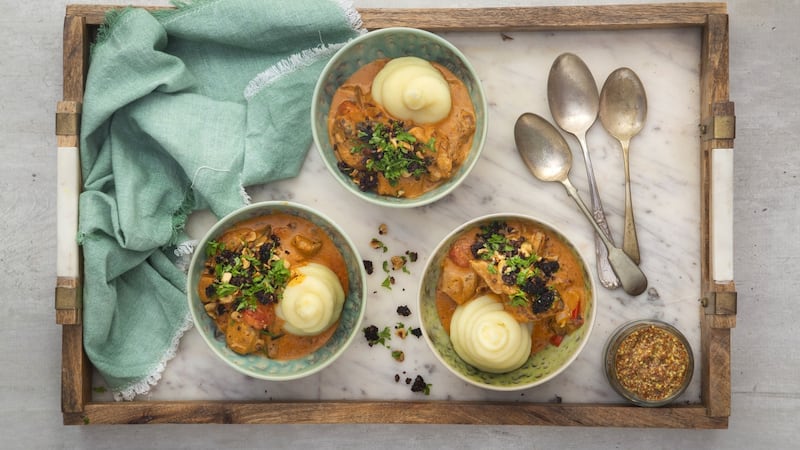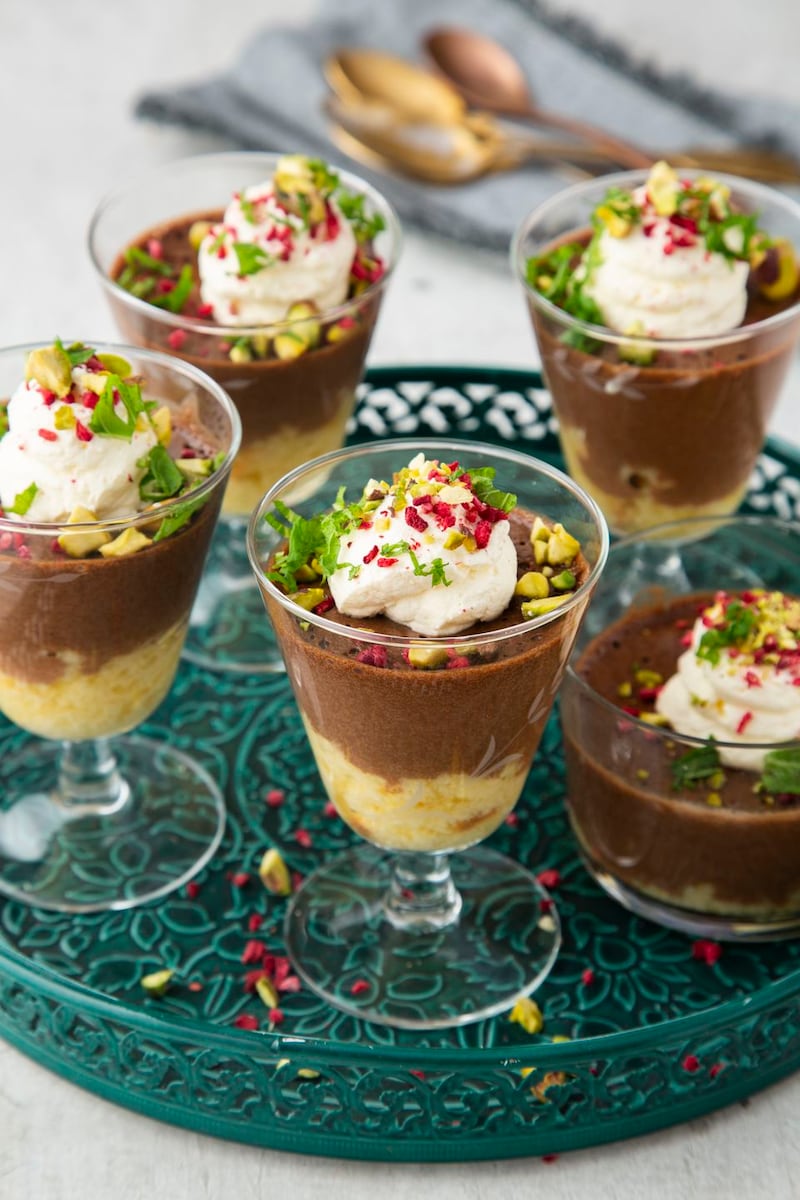This is party season central and the question is: What to cook? Bowl food is an effortless way to feed the masses, straddling the divide between finger food and a full sit-down meal.
Offering your guests a hot, tasty bowl of delicious fare keeps hunger at bay while seamlessly accommodating the all-important flow of your party. It is the perfect way to avoid interrupting those deep conversations or laughter relays taking place around the room.
One of my clients once told me she wanted to “feed but not fatten” her guests, so bowl food fits this purpose beautifully.

In a kitchen with a regular four-ring cooker, you can cater for up to 30 guests with a choice of two dishes. All the work is done beforehand, so on the night of the party it’s just a matter of reheating the main dishes and cooking pasta, rice, or making mashed potato.
Bowls are much easier to eat from, using either a fork or a dessert spoon. It’s a great option when you have standing room only and avoids guests awkwardly attempting to balance plates on their laps.
Keep an eye out for suitable bowls that are inexpensive and not too big (most chain stores have a great selection). I usually warm them in the oven beforehand, just to take the chill out of them. But don’t allow them to get too hot to handle!
SLOW-COOKED LAMB RAGU WITH RIGATONI
Serves 6

There is nothing heartier than slow-cooked lamb ragu with pasta – it is literally a hug in a bowl. This recipe can be bulked-up, and made two-three days beforehand – the flavour will improve each day. Remember, this is bowl food so forget about long strands of spaghetti or pappardelle (and, by extension, dry-cleaning costs) and think of the more manageable rigatoni, penne or fusilli.
The quality of the pasta you use is of the utmost importance. I have recently discovered a brand called Rummo in my local SuperValu, which I find to be excellent. Cheap pasta can tend to have a gummy, glutinous texture which is difficult to cook with, sticking together when cooked and refusing to absorb sauce.
Ingredients
4tbsp olive oil
1kg lamb shoulder, cut into 3cm cubes
50g diced pancetta
2 onions, finely chopped
6 garlic cloves
1 carrot, finely chopped
1 celery stalk, finely chopped
1 red pepper, diced
250ml red wine
½tsp dried chilli flakes
1tbsp fresh thyme leaves or 1tsp dried thyme
2 x 400g tins of good-quality chopped Italian plum tomatoes
Salt, black pepper
500g rigatoni
Heaps of freshly grated Parmesan cheese
Method
1. Warm two tablespoons of the oil in a heavy pan (with a lid) over medium heat. When it is hot, add the lamb and fry in batches until sealed and browned on all sides. Scoop the lamb out of pan and set aside.
2. Add the rest of the oil to the pan. When it is hot, stir in the pancetta, onions, garlic, carrot, pepper and celery, turn down the heat and cook slowly over a medium heat until softened and turning lightly golden. The aim here is to caramelise the vegetables to bring out their wonderful sweetness – this will take about 10 minutes.
3. Pour in the wine and bring to the boil. Vigorously scrape up any crusty caramelised juices from the bottom of the pan and let the wine boil hard for a minute or two so that all the alcohol bubbles away. Stir in the tomatoes, then adjust the heat so that the liquid barely simmers.
3. Return the lamb to the pan and sprinkle in the chilli and thyme. As soon as the braise starts to bubble, turn down the heat to low and let barely simmer on top of the stove or in a 150ºC, or equivalent, oven until the lamb is meltingly tender, about 1 ½ to two hours. Add salt and pepper to taste.
4. Set aside and allow to cool. Ideally, this should be made the day before it is needed. When reheating, allow it to simmer over a gentle heat for about 10 minutes until completely heated through.
5. Bring a large pot of water to the boil, add a large pinch of salt and add the pasta. The pasta should cook to al dente in about seven minutes. Drain the pasta and stir into the lamb ragu, spoon into warm bowls and sprinkle generously with Parmesan.
PORK, MUSTARD, AND TOMATO CASSEROLE WITH BLACK PUDDING, HAZELNUTS AND PARSLEY
Serves 8

Shoulder of pork is perfect for slow cooking – you may have to pre-order the pork beforehand though, as many supermarkets and butchers seem to stock only loin or fillet (both of which tend to get tough when cooked in a casserole due to the lack of connective tissue).
Ingredients
750g boned shoulder of pork, trimmed
6 tbsp oil
2tsp chopped fresh rosemary
25g butter
3 medium onions, peeled and quartered
3 garlic cloves, peeled and crushed
4 tbsp tomato paste
100ml dry sherry
2 tsp plain flour
250ml chicken stock
200ml apple juice (I use our local Crinnaghtaun apple juice, which is unsweetened. Sweetened apple juice doesn't work for cooking – it's difficult to correct the flavour afterwards)
2 tsp dark soy sauce
Salt and pepper
450g small, dark, flat mushrooms
3 tbsp wholegrain mustard
250g cherry tomatoes
100g black pudding – pan-fried and broken up
1 tbsp hazelnuts, roasted and roughly chopped
Handful of parsley, stems removed and chopped
Method
1. Cut the pork into 2.5 cm (1in) chunks and place in a bowl. Add two tablespoons of oil and the rosemary; cover and set aside to marinate in a cool place for two hours.
2. Heat the butter in a flameproof casserole and fry the pork in batches to a rich golden brown. Remove with a slotted spoon and set aside. Lower the heat, add the onions and cook for five-seven minutes, or until slightly softened and golden. Add the garlic and tomato paste and fry for two-three minutes. Pour in the sherry and bring to a simmer and allow to gently bubble for a few minutes, until reduced by half.
3. Stir in the flour, then pour in the stock and apple juice. Bring to a gentle simmer. Return the pork to the pan with the soy sauce and seasoning. Simmer for five minutes, then cover tightly and cook at 180ºC, or equivalent, for one-1¼ hours, until tender.
4. In the meantime, heat the remaining oil in a large frying pan. Add the mushrooms and fry briskly for three-four minutes. Season and add to the casserole before the end of the cooking time.
5. Stir in the mustard, return to the boil and add the cherry tomatoes. Heat through for one-two minutes.
6. Top with a sprinkling of the black pudding, hazelnuts and parsley, and serve with mash.
TIPS FOR MULTIPLYING OUT RECIPES
When you are making dishes in larger amounts, doubling and trebling the ingredients, be aware that not all ingredients need to be multiplied out – for example, in the pork recipe, add the mustard to taste as opposed to following the recipe exactly.
Top tips for mashed potato:
I usually work on a basis of 250g of peeled potatoes per person.
Use a good Irish potato, such as a Rooster.
For smooth mashed potatoes, put the potatoes through a mouli or potato ricer before adding milk and butter.
Use plenty of butter.
SRI LANKAN-INSPIRED BEETROOT AND SWEET POTATO CURRY
Serves 8

I find, as a caterer, that increasingly more guests favour vegetarian and vegan options. Gone are the days when vegetarianism was the exception. I usually make this a few hours or a day before serving to allow the flavours to develop. I love this stew on its own but it can be accompanied with some wholegrain basmati rice.
Ingredients
A good glug of rapeseed oil
2 medium onions, peeled and diced
3 cloves of garlic, diced
2 tbsp ginger, grated
2 red chillies, deseeded and finely sliced
4 sweet potatoes, peeled and cut into chunks
3 beetroot, peeled and cut into chunks
2 tsp garam masala
2 tsp cumin
2 tsp ground coriander
2 tsp turmeric
300ml vegetable stock
1 x 400g can coconut milk
2 x 400g cans of chickpeas, drained
300g baby spinach leaves
A squeeze of lemon juice, sugar, salt and pepper to season
Serve with a dollop of Greek yoghurt or soy yoghurt, a sprinkling of spiced cashews and fresh coriander.
Method
1. Heat the oil in a heavy-based saucepan, add the onions and garlic and sweat until golden, then add the chilli and ginger and cook for a minute or two, then add the sweet potato and beetroot, stir to coat with oil and stir fry for a few minutes. Add the rest of the spices, cook for a further five minutes and cover with vegetable stock.
2. Allow to simmer for 30 minutes until the vegetables are soft, then add the coconut milk and chickpeas and simmer for another 10 minutes. Then check for seasoning. I usually add a dessertspoon of sugar, then balance the flavour with a squeeze of lemon juice and salt and pepper to taste.
3. Before serving, re-heat the stew, shred the spinach and divide between the bowls. Ladle the stew on top and serve with a dollop of Greek yoghurt or soy yoghurt and top with a sprinkle of spiced cashew nuts and finally top with some shredded coriander leaves.
SPICED CASHEWS
I always have a jar of these (or something similar) in the kitchen to add a little crunch and texture to salads, soups and stews.
Ingredients
120g cashew nuts, roasted and salted – roughly chopped
3 tbsp sesame seeds
1 tsp cumin seeds
1 tbsp coriander seeds – lightly crushed
A pinch of paprika, chilli flakes and Maldon sea salt
Method
Toast the sesame seeds in a dry pan, then set aside. Next, roast the cumin and coriander seeds until they start to hop then add to the sesame seeds. Add the cashew nuts, paprika, chilli flakes and salt and mix together. Allow to cool and keep in an airtight container.
CHOCOLATE JAFFA POTS
Serves 10

This recipe isn’t an exact science, as it really depends on the portion size. I usually get about 10 small glasses out of this recipe.
Ingredients
Juice of 2 large oranges
1 trifle sponge (shop-bought is fine for this)
150ml cream
150g dark chocolate, broken into small pieces
Finely grated zest of one orange
3 eggs, separated
Method
1. Cut the sponge into cubes and pop into the bottom of each glass, taking up about a third of the space. Pour a little orange juice on top to lightly soak the sponge.
2. Place the cream into a medium-sized saucepan and bring to the boil, take off the heat and stir in the chocolate and orange zest and stir until chocolate is melted, then beat in the three egg yolks.
3. Whisk the egg whites until stiff and using a metal spoon, gently fold into the chocolate sauce, being careful not to knock out the air.
4. Divide the mousse between the 10 glasses and leave to chill and set for a minimum for two hours, or overnight. Once set, I usually cover each one with a little clingfilm to avoid the mousse adopting other flavours in the fridge.
5. Take out of the fridge an hour before you serve. Serve with a dollop of cream and decorate with some finely shredded mint, or maybe some crushed pistachio nuts – whatever takes your fancy.




















